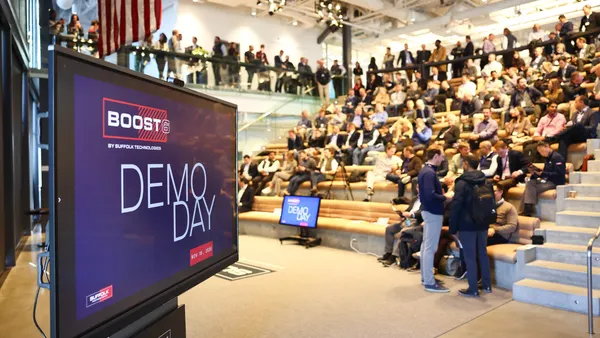Homebuilding is a constantly evolving industry. As populations and buyers change, companies must find ways to adapt to their new preferences. On top of that challenge, builders are still dealing with the ramifications of the 2008 housing crash. With the market heavily influenced by broader economic conditions, the fear of another recession is constantly looming overhead.
However, Lou Steffens, East Area President for the nation's 7th largest homebuilder, Taylor Morrison, thrives on those challenges and looks at them as motivators that keep things interesting in the industry. "Every aspect of this business is so exciting," he said.
The 20-year homebuilding industry veteran has seen the highest peaks and the lowest valleys of housing sentiment during his career, and he is optimistic that the market's slow but steady recovery is creating an environment for a sustained period of strength. And he hopes the younger generation is taking notice of that opportunity.
In an in-depth interview with Construction Dive, Steffens explores some of the biggest successes and pitfalls of the homebuilding industry, as well its most significant challenges — led by the ongoing lack of skilled labor and incoming talent who can one day take over leadership roles.
Editor's note: This interview has been edited and condensed for clarity.
What do you think are some of the biggest challenges that homebuilders are currently facing?
STEFFENS: I would say the availability of a trained workforce. We’re just not seeing a lot of new talent that’s come in through the trades. The pride of workmanship that used to exist when I got into the business compared to now is significantly changed. There used to be a lot of pride in being a framer or a trim carpenter. It just seems that now, every kid that grows up is supposed to go to college. The trades don’t get the respect they used to. I think that’s sad because it’s enviable work, and they make such a big difference in the world. But it’s definitely put pressure on our business and our competitors in terms of the availability of skilled labor.
Also talent in the homebuilding industry. Through the downturn, not too many people were getting into homebuilding at that point in time. There’s not a lot of new talent in the homebuilding arena in terms of skill sets and folks coming through the ranks to be our future leaders.
What are some tactics Taylor Morrison is using to try and draw more talent into the industry?
STEFFENS: As a company, we’ve worked with the military getting veterans interested in homebuilding. Our CEO has been very involved in the leading builders' association in terms of working with vocational schools. Other opportunities to get people starting from high school to talk to students to have an interest getting into the trades or developing their own business over time. It’s probably going to take years to see the dramatic impact of that, but you have to start somewhere. The skilled labor that we need to build these houses doesn’t exist, like other industries that are short on good trades and labor.
How does Taylor Morrison try to set itself apart from other homebuilders when pursuing trades?
STEFFENS: As a company, we try to do all we can do to be the employer of choice. Making sure our job sites are ready when they come out, all the paperwork that they need is in order, we pay them regularly. We can’t control the complete supply of the trades, but at least of the supply that is out there, we try to make us a more desirable choice to work for. A lot of others are singing the blues. A lot of the other builders throw money at the trades to leave the job sites they’re on and come to them. That’s the short-term solution. I think the long-term solution is treating them with respect and making their lives as easy as they could possibly be so they’re efficient in what they’re trying to accomplish and cut out the headaches.
Why do you think careers in the trades are less respected now?
STEFFENS: I think part of it is this belief culturally that’s pushed from the time you start school to go to college. Talking to my parents growing up, it was well-respected to be a plumber or electrician. But now it just doesn’t get a lot of talk. That is a great career path. I wish I knew the answer because I think it’s a great opportunity for young folks to get into that can be very rewarding financially too. There’s a lot of kids graduating that couldn’t find any work after college. While a lot of those folks were looking for work after graduating, we were dying for good trades. I just think there’s an oversupply. It’s great if you have that college education, but I think you could be very successful in starting these small businesses. We need to see a new generation of these folks come up for our future.
Why do you think homebuilding is an attractive career?
STEFFENS: We build these beautiful communities where you can say 'I was part of building this.' Being part of a community from its infancy and having them grow and all the great families that are coming into these locations. You can go back to them in 10 or 20 years, and they still look great. I take a lot of pride, and I think a lot of the trades do too. They’re creating something that is really people’s biggest purchase of their life and their dreams for their families. Every aspect of this business is so exciting. Building a widget is the same thing every day. Our communities always change and evolve and look different based on the consumers’ taste and depending on who we’re trying to serve. There’s a lot of variety and it’s ever-evolving.
In your time in housing, what are some of the biggest changes you’ve seen in the industry?
STEFFENS: One thing I’ve seen is the size of the multicultural buyer group that 20 years ago we didn’t have. We did an analysis, and over the last 20 years, the surnames have changed dramatically. That has been a big change, and that’s given us the ability to better understand how to best serve those buyers.
Little things with homes have also changed over the years in terms of what people look for, open design, a Messy Kitchen, connectivity from master closets into laundry rooms. One thing that’s been interesting from both active adults and millennials is pets — how much that has become a big deal. We design a lot of times into our communities dog parks and events related to the pets being part of the activities in a community. We did an analysis on buyers, and one-third of homebuyers have children and two-thirds have pets. Even certain areas in the home that are set aside for pets. Their own little room or dog washes. It’s pretty cool.
Would you say homebuyer preference is leaning toward larger or smaller homes?
STEFFENS: It truly depends on the buyer profiles. Through the downturn one thing that happened was with low interest rates, the more affluent folks were probably not impacted as much financially. There was just more demand through the downturn for the move-up side of the business, and the affordable side fell off the most. Those were the folks with the most financial issues. So I think those generally on average are bigger square foot homes, the move-up to luxury side. But there’s been a huge resurgence now that those affordable buyers have worked out their credit issues. They’re buying homes much more significantly now, and more smaller homes.
I’ve been thinking about what will the average square footage be over the next couple of years because I think it’s been skewed a bit because there’s more move-up to luxury sales. As the more affordable segments come back more quickly, I’d say more stagnation in growth in the move-up to luxury. I think there could be a moving back to the norm on average square footage because just by nature, the more affordable buyers can’t afford the bigger homes.
Why have builders been slow to get back into the entry-level market?
STEFFENS: I think a lot of it had to do with (buyers') financial situations and availability of mortgages through the downturn. There just wasn’t a lot of money available for those buyers. I think that was the biggest portion of it. But there’s this big conversation of whether millennials are more comfortable living in apartments for longer, will they ever buy homes. The research we’ve seen is that at a certain life stage, similar to other generations, they’ll still buy a home. They’ll have children or get married. They exhibit a lot of the same characteristics. I think it has a lot more to do with the credit situation, their availability for the down payment — it was very difficult through the downturn. In the affordable communities we do offer, we’re seeing a lot of demand. That might be more of an accelerating part of the market than maybe the move-up side. I think the move-ups are more stable, but it seems to me the more affordable segments are the ones growing the quickest today.
With that increased demand, will Taylor Morrison ramp up construction of affordable homes?
STEFFENS: I think we have. It seems like builders are birds of a feather flock together. We were one of the first to move to the move-up to luxury side when custom builders went broke. As we’ve done that, everybody else watched and wanted to get into this segment. Now they’re in the segments we’re in, and in many instances we’re bringing our price points down. As they’re all going in saturating that move-up to luxury side, we’re generally going more down in price point. Not super affordable, but first-time move-up.
Overall, how would you describe your attitude toward the housing market?
STEFFENS: It’s been more of a slow and steady recovery versus a huge spike. What happens with spikes is there’s usually a valley down below. I think it’s more of a slow, steady recovery, and I think it’s been more healthy for the long run because prices don’t spike super quickly and come down and retreat. It’s hard to gain footing when it’s going like gangbusters then you bust and it comes back down. The fact that it’s been more of a slow and steady recovery (means that) hopefully the juice will last a lot longer. If you look at inventory from both resale and new homebuilders, there’s not a ton of inventory. You’re not seeing an overbuilding situation yet. Maybe people have been a little bit more cautious going into this after the last recession in how they look at their future.
Do you think builders have needed to change the way they look at the market after the downturn?
STEFFENS: I think so. There have been a lot of lessons learned. To me, the true test will be to take what you learned from the recession and don’t forget it through this next one. Because as good as it is today, we’ve seen how quickly that can change. Be judicious on how you manage the business and your spend and don’t get too far ahead of yourself. Obviously you have to take risks in this business, but don’t always assume everything will go your way. It’s how you position yourself to have more of a soft landing so you don’t fall down and break all your bones.




















